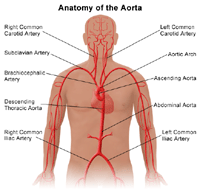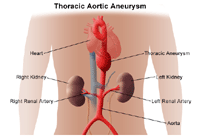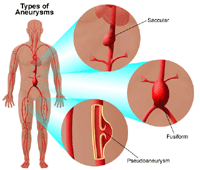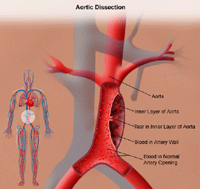Thoracic Aortic Aneurysm
What is a thoracic aortic aneurysm?
 |
| Click Image to Enlarge |
A thoracic aortic aneurysm, also called TAA, is a bulging, weakened area in the wall of the aorta (the largest artery in the body), resulting in an abnormal widening or ballooning greater than 50 percent of the normal diameter (width).
The aorta extends upward from the top of the left ventricle of the heart in the chest area (ascending thoracic aorta), then curves downward (aortic arch) through the chest area (descending thoracic aorta) into the abdomen (abdominal aorta). The aorta delivers oxygenated blood pumped from the heart to the rest of the body.
An aneurysm can be characterized by its location, shape, and cause. A thoracic aortic aneurysm is located in the chest area. The thoracic aorta can be divided into segments: ascending aorta, aortic arch, and descending aorta, as described above. An aneurysm may be located in one of these areas and/or may be continuous throughout the aorta. An aneurysm called a thoracoabdominal aneurysm involves a thoracic aortic aneurysm extending down to the abdominal aorta.
 |
| Click Image to Enlarge |
Thoracic aneurysms do not occur as often as abdominal aneurysms. The descending thoracic aorta is the most common location of a thoracic aneurysm, followed by the ascending segment, then the arch. The location of an aneurysm is distinctly connected with the cause, course, and treatment of a thoracic aneurysm.
Types of thoracic aortic aneurysms:
The shape of an aneurysm is described as being fusiform or saccular which helps to identify a true aneurysm. A true aneurysm involves all three layers of the arterial blood vessel wall. The more common fusiform-shaped aneurysm bulges or balloons out on all sides of the aorta. A saccular-shaped aneurysm bulges or balloons out only on one side.
A pseudoaneurysm, or false aneurysm, is an enlargement of only the outer layer of the blood vessel wall. A false aneurysm may be the result of prior surgery or trauma. Sometimes, a tear may occur on the inside layer of the vessel resulting in blood entering the layers of the blood vessel wall, creating a pseudoaneurysm.
 |
| Click Image to Enlarge |
The aorta is under constant pressure from blood being ejected from the heart. With each heartbeat, the walls of the aorta expand and spring back, exerting continual pressure or stress on the already weakened aneurysm wall. Therefore, there is a potential for rupture (bursting) or dissection (separation of the layers of the thoracic aortic wall), which may cause life-threatening hemorrhage (uncontrolled bleeding) and, potentially, death.
Once formed, an aneurysm will gradually increase in size and there will be a progressive weakening of the aneurysm wall. Treatment for a thoracic aneurysm may include surgical repair or removal of the aneurysm to prevent rupture.
What causes a thoracic aortic aneurysm to form?
Thoracic aortic aneurysms may be caused by different disease processes, especially in respect to their location.
Examples of different locations of thoracic aortic aneurysms and their causes may include, but are not limited to, the following:
|
Location of Thoracic Aortic Aneurysm
|
Causes Associated with Aneurysm Type
|
|
Ascending Thoracic Aneurysm
|
-
cystic medial degeneration (necrosis) - breaking down of the tissue of the aortic wall. This is the most common cause of this type of thoracic aortic aneurysm.
-
genetic disorders which affect the connective tissue, such as Marfan syndrome and Ehlers-Danlos syndrome
-
family history of thoracic aortic aneurysm with no incidence of Marfan syndrome
-
atherosclerosis - hardening of the arteries caused by a build-up of plaque in the inner lining of an artery. This is a rare cause of ascending thoracic aortic aneurysm.
-
infection, syphilis (rare causes of thoracic aortic aneurysm)
|
|
Aortic Arch Thoracic Aneurysm
|
|
|
Descending Thoracic Aortic Aneurysm
|
Atherosclerosis is most often associated with descending thoracic aneurysms, and is thought to play an important role in aneurysmal disease, including the risk factors associated with atherosclerosis such as:
-
age (greater than 55)
-
male gender
-
family history (first-degree relatives such as father or brother)
-
genetic factors
-
hyperlipidemia (elevated fats in the blood)
-
hypertension (high blood pressure)
-
smoking
-
diabetes
|
What are the symptoms of a thoracic aortic aneurysm?
Thoracic aortic aneurysms may be asymptomatic (without symptoms) or symptomatic (with symptoms). Symptoms of a thoracic aneurysm may be related to the location, size, and growth rate of the aneurysm.
Severe onset of pain associated with a thoracic aneurysm may be a sign of a life-threatening medical emergency.
Symptoms of an ascending thoracic aneurysm may include, but are not limited to, the following:
-
pain in the chest, neck, and/or back
-
swelling of head, neck, and arms as a result of pressure on large blood vessels
-
heart failure - an ascending aneurysm may affect the heart valves, causing blood to back up into the heart
Symptoms of an aortic arch aneurysm or a descending thoracic aneurysm may include, but are not limited to, the following:
-
wheezing, coughing, or shortness of breath as a result of pressure on the trachea (windpipe)
-
coughing up blood (hemoptysis)
-
hoarseness as a result of pressure on the vocal cords
-
difficulty swallowing (dysphagia) due to pressure on the esophagus
-
pain in the chest and/or back
The symptoms of a thoracic aortic aneurysm may resemble other conditions. Consult your physician for a diagnosis.
How is a thoracic aortic aneurysm diagnosed?
In addition to a complete medical history and physical examination, diagnostic procedures for a thoracic aortic aneurysm may include any, or a combination, of the following:
-
computed tomography scan (Also called a CT or CAT scan.) - a diagnostic imaging procedure that uses a combination of x-rays and computer technology to produce cross-sectional images (often called slices), both horizontally and vertically, of the body. A CT scan shows detailed images of any part of the body, including the bones, muscles, fat, and organs. CT scans are more detailed than standard x-rays.
-
magnetic resonance imaging (MRI) - a diagnostic procedure that uses a combination of large magnets, radiofrequencies, and a computer to produce detailed images of organs and structures within the body.
-
echocardiogram (Also called echo.) - a procedure that evaluates the structure and function of the heart by using sound waves recorded on an electronic sensor that produce a moving picture of the heart and heart valves, as well as the structures within the chest, such as the lungs, mediastinum (area in the chest containing the heart, aorta, trachea, esophagus, thymus, and lymph nodes), and pleural space (space between the lungs and the interior wall of the chest).
-
transesophageal echocardiogram (TEE) - a diagnostic procedure that uses echocardiography to assess the presence of an aneurysm, the condition of heart valves, and/or presence of a dissection (tear) of the lining of the aorta. TEE is performed by inserting a probe with a transducer on the end down the throat.
-
chest x-ray - a diagnostic test which uses invisible electromagnetic energy beams to produce images of internal tissues, bones, and organs onto film.
-
arteriogram (angiogram) - an x-ray image of the blood vessels used to evaluate various conditions, such as aneurysm, stenosis (narrowing of the blood vessel), or blockages. A dye (contrast) will be injected through a thin flexible tube placed in an artery. The dye makes the blood vessels visible on an x-ray.
Treatment for thoracic aortic aneurysm:
Specific treatment will be determined by your physician based on:
-
your age, overall health, and medical history
-
extent of the disease
-
your signs and symptoms
-
your tolerance for specific medications, procedures, or therapies
-
expectations for the course of the disease
-
your opinion or preference
Treatment may include:
-
routine MRI or CT - to monitor the size and rate of growth of the aneurysm
-
controlling or modifying risk factors - steps such as quitting smoking, controlling blood sugar if diabetic, losing weight if overweight or obese, and controlling dietary fat intake may help improve your health in preparation for aneurysm repair
-
medication - to control factors such as hyperlipidemia (elevated levels of fats in the blood) and/or high blood pressure
-
surgery
-
thoracic aortic aneurysm open repairThe type of surgical repair of a thoracic aortic aneurysm will depend on several factors: the location of the aneurysm, the type of aneurysm, and the patient's tolerance for the procedure. For an ascending or aortic arch aneurysm, a large incision may be made through the breastbone (median sternotomy). If an ascending aneurysm involves damage to the aortic valve of the heart, the valve may be repaired or replaced during the procedure. For a descending aneurysm, a large incision may extend from the back under the shoulder blade around the side of the rib cage to just under the breast (thoracotomy). These approaches allow the surgeon to visualize the aorta directly to repair the aneurysm.
-
endovascular aneurysm repair (EVAR)EVAR is a procedure which requires only small incisions in the groin, along with the use of x-ray guidance and specially-designed instruments, to repair the aneurysm by inserting a tube, called a stent-graft, inside the aorta. At this time, the only thoracic aneurysms repaired by means of EVAR are descending thoracic aneurysms.
Asymptomatic aneurysms may not require surgical intervention until they reach a certain size or are noted to be increasing in size over a certain period of time. Parameters considered when making surgical decisions include, but are not limited to, the following:
-
aneurysm size greater than 5.5 to 6 centimeters (greater than two inches)
-
aneurysm growth rate 0.5 centimeters (slightly less than one-fourth inch) over a period of six months to one year
-
presence of genetic disorders or familial history of thoracic aneurysms
-
patient's ability to tolerate the procedure
For symptomatic aneurysms, immediate intervention is indicated.
Thoracic Aortic Dissection
What is aortic dissection?
An aortic dissection begins with a tear in the inner layer of the aortic wall, usually in the ascending or descending thoracic aorta. The aortic wall is made up of three layers of tissue. When a tear occurs in the innermost layer of the aortic wall, blood is then channeled into the wall of the aorta separating the layers of tissues. This generates great pressure in the aortic wall with a potential to rupture (burst). Aortic dissection can be a life-threatening emergency.
 |
| Click Image to Enlarge |
What causes aortic dissection?
The cause of aortic dissection is still under investigation. However, there are several risk factors associated with aortic dissection, such as:
-
hypertension (high blood pressure)
-
connective tissue disorders, such as Marfan's disease, Ehlers-Danlos syndrome, and Turner's syndrome
-
cystic medial disease (a degenerative disease of the aortic wall)
-
aortitis (inflammation of the aorta)
-
atherosclerosis
-
existing thoracic aneurysm
-
bicuspid aortic valve - presence of only two cusps, or leaflets, in the aortic valve, rather than the normal three cusps
-
trauma
-
coarctation of the aorta (narrowing of the aorta)
-
hypervolemia (excess fluid or volume in the circulation)
-
polycystic kidney disease (a genetic disorder characterized by the growth of numerous cysts filled with fluid in the kidneys)
What are the symptoms of aortic dissection?
The most commonly reported symptom of an acute aortic dissection is severe, constant chest and/or upper back pain, sometimes described as "ripping" or "tearing." The pain may be "migratory," moving from one place to another, according to the direction and extent of the dissection.
How is aortic dissection diagnosed?
In addition to a complete medical history and physical examination, diagnostic procedures for an aneurysm may include any, or a combination, of the following:
-
computed tomography scan (Also called a CT or CAT scan.) - a diagnostic imaging procedure that uses a combination of x-rays and computer technology to produce cross-sectional images (often called slices), both horizontally and vertically, of the body. A CT scan shows detailed images of any part of the body, including the bones, muscles, fat, and organs. CT scans are more detailed than general x-rays.
-
transesophageal echocardiogram (TEE) - a diagnostic procedure that uses echocardiography to assess the heart's function and structures. A transesophageal echocardiogram is performed by inserting a probe with a transducer down the esophagus. By inserting the transducer in the esophagus, TEE provides a clearer image of the heart because the sound waves do not have to pass through skin, muscle, or bone tissue.
The physician will determine the most appropriate examination. When a diagnosis of an acute aortic dissection is confirmed, immediate medical care and intervention, such as surgery, may be necessary in some cases.
Click here to view theOnline Resources of Cardiovascular Disease